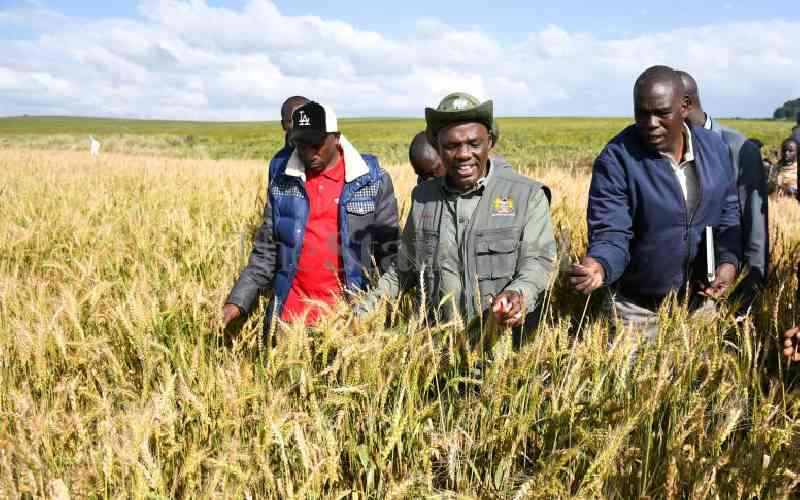
A new report shows that the majority of Kenyans’ dependence on agriculture as their main source of livelihood has dropped by 7.5 per cent in the last five years.
This raises fears about the future of this economic activity, which is the foundation for most small businesses in the country.
According to the 2024 FinAccess Household Survey, fewer Kenyans, especially the youth are engaged in agriculture, with more individuals preferring casual labour or owning a business.
The study shows that most of those engaging in agriculture are 55 years old and above. Additionally, those who depend on agriculture as their main source of livelihood dropped from 25.4 per cent in 2019 to 17.9 per cent in 2024.
The survey shows individuals may be moving from agriculture to either employment or running their own business.
Wealth quintiles
Further, when analysed as per wealth quintiles, agriculture is not attractive to those of the highest (wealth quintile), where only 4.5 per cent practise it. Those at the lowest wealth quintile practise it more at 27.6 per cent.
The survey has five categories of wealth quintiles—highest, fourth, middle, second and lowest—which are based on living standards.
The survey says the findings indicate that respondents in the lower wealth quintiles rely more on casual work (34.1 per cent in the second lowest quintile and 29.2 per cent in the lowest quintile), agriculture (27.6 per cent in the lowest quintile), and dependence (23.2 per cent in the lowest quintile).
“In contrast, higher quintiles see a shift toward employment (27.2 per cent in the highest quintile) and own businesses (22.3 per cent in the highest quintile and 20.1 per cent in the fourth quintile), with less reliance on agriculture and casual work,” the survey reads in part.
Agriculture is the country’s main contributor to economic growth, representing 21.8 per cent of the gross domestic product (GDP), according to the 2024 Economic Survey. A larger component of this GDP (15.4 per cent) comes from growing crops.
The survey engaged over 28,000 households across the 47 counties.
According to the survey compiled by the Central Bank of Kenya (CBK), Kenya National Bureau of Statistics (KNBS), and FSD Kenya, the proportion of those who depended on agriculture as their main source of livelihood was 34.2 per cent in the age category of above 55.
Those between 46 and 55 were 29.6 per cent, 36 and 45 (19.5 per cent), 26 and 35 (14.1 per cent), while 18 and 25 was 8.1 per cent.
This breakdown shows that youth account for 22.2 per cent of those whose main livelihood is agriculture.
The survey explains younger individuals (18–25 years) are primarily dependent on employment (39.4 per cent) and casual work (27.5 per cent), with minimal participation in agriculture (8.1 per cent).
“Older groups, particularly those above 55, depend more on agriculture (34.2 per cent) and less on casual work (11.7 per cent) or employment (4.0 per cent). Middle-aged groups (26–55 years) balance between casual work, agriculture, and running their own businesses and less on dependence,” the survey says.
The drop in dependence on agriculture is explained by an increase over the period in those who venture into casual labour employment or choose to become dependent.
In 2019, the population that depended on agriculture was 25.4 per cent, which dropped to 18.3 per cent in 2021 and later 17.9 per cent in 2024.
During this period, those dependent on casual labour grew from 24.3 per cent in 2019 to 30.1 per cent in 2021 before dropping to 26.5 per cent in 2024. The population that owned business was 18.0 per cent in 2019, which dropped to 15.0 per cent in 2021 and grew to 16.7 per cent in 2024, while those who became dependent grew from 17.6 per cent in 2019 to 25.2 per cent in 2021 and dropped slightly to 22.3 per cent in 2024.
There was not much growth among the employed as the figure corrected itself to pre-Covid levels of 13.2 per cent in 2024, which was the same in 2019 before dropping to 11.2 per cent in 2021. Looking at the main challenges faced by those practising agriculture also partly explains why the demographics are dependent on it.
For example, the high cost of input is a major issue, which can only be easily handled by those with disposable income, most likely the older generation. Agriculture was one of the top three major sources of livelihood for the adult population in 2024.
The findings indicated that drought was highly ranked as the leading threat at 19.2 per cent. High cost of inputs came second with 17.3 per cent, closely followed by pests and diseases at 16.6 per cent,” the survey says.
The survey adds that the primary source of agricultural financing is reinvested income from farming (49.3 per cent), with slightly higher reliance among females (50.3 per cent) than males (48.4 per cent).
“Notable gender differences include higher dependence on salary income by males (22.4 per cent) compared to females (11.0 per cent) and greater reliance on family or community assistance by females (20.5 per cent) versus males (9.5 per cent),” the survey says.
 The Standard Group Plc is a multi-media organization with investments in media platforms spanning newspaper print
operations, television, radio broadcasting, digital and online services. The Standard Group is recognized as a
leading multi-media house in Kenya with a key influence in matters of national and international interest.
The Standard Group Plc is a multi-media organization with investments in media platforms spanning newspaper print
operations, television, radio broadcasting, digital and online services. The Standard Group is recognized as a
leading multi-media house in Kenya with a key influence in matters of national and international interest.











